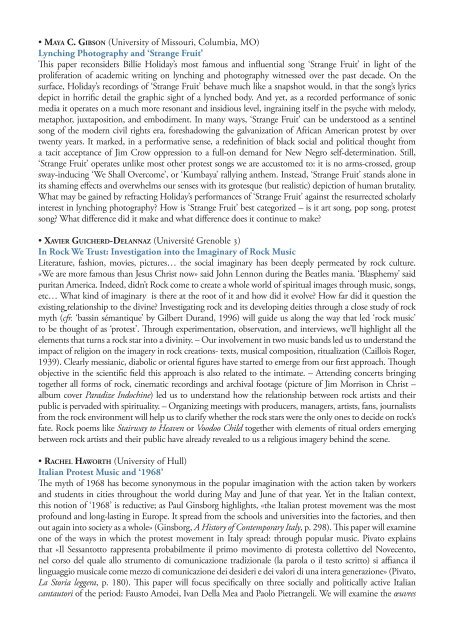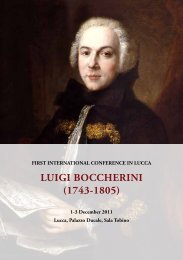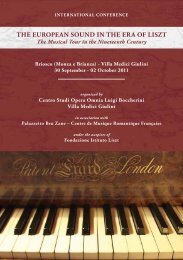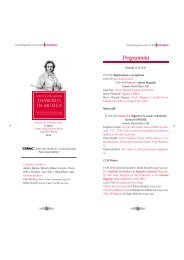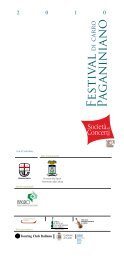PROGRAMME - Centro Studi Opera Omnia Luigi Boccherini
PROGRAMME - Centro Studi Opera Omnia Luigi Boccherini
PROGRAMME - Centro Studi Opera Omnia Luigi Boccherini
You also want an ePaper? Increase the reach of your titles
YUMPU automatically turns print PDFs into web optimized ePapers that Google loves.
• Maya C. Gibson (University of Missouri, Columbia, MO)Lynching Photography and ‘Strange Fruit’This paper reconsiders Billie Holiday’s most famous and influential song ‘Strange Fruit’ in light of theproliferation of academic writing on lynching and photography witnessed over the past decade. On thesurface, Holiday’s recordings of ‘Strange Fruit’ behave much like a snapshot would, in that the song’s lyricsdepict in horrific detail the graphic sight of a lynched body. And yet, as a recorded performance of sonicmedia it operates on a much more resonant and insidious level, ingraining itself in the psyche with melody,metaphor, juxtaposition, and embodiment. In many ways, ‘Strange Fruit’ can be understood as a sentinelsong of the modern civil rights era, foreshadowing the galvanization of African American protest by overtwenty years. It marked, in a performative sense, a redefinition of black social and political thought froma tacit acceptance of Jim Crow oppression to a full-on demand for New Negro self-determination. Still,‘Strange Fruit’ operates unlike most other protest songs we are accustomed to: it is no arms-crossed, groupsway-inducing ‘We Shall Overcome’, or ‘Kumbaya’ rallying anthem. Instead, ‘Strange Fruit’ stands alone inits shaming effects and overwhelms our senses with its grotesque (but realistic) depiction of human brutality.What may be gained by refracting Holiday’s performances of ‘Strange Fruit’ against the resurrected scholarlyinterest in lynching photography? How is ‘Strange Fruit’ best categorized – is it art song, pop song, protestsong? What difference did it make and what difference does it continue to make?• Xavier Guicherd-Delannaz (Université Grenoble 3)In Rock We Trust: Investigation into the Imaginary of Rock MusicLiterature, fashion, movies, pictures… the social imaginary has been deeply permeated by rock culture.«We are more famous than Jesus Christ now» said John Lennon during the Beatles mania. ‘Blasphemy’ saidpuritan America. Indeed, didn’t Rock come to create a whole world of spiritual images through music, songs,etc… What kind of imaginary is there at the root of it and how did it evolve? How far did it question theexisting relationship to the divine? Investigating rock and its developing deities through a close study of rockmyth (cfr. ‘bassin sémantique’ by Gilbert Durand, 1996) will guide us along the way that led ‘rock music’to be thought of as ‘protest’. Through experimentation, observation, and interviews, we’ll highlight all theelements that turns a rock star into a divinity. – Our involvement in two music bands led us to understand theimpact of religion on the imagery in rock creations- texts, musical composition, ritualization (Caillois Roger,1939). Clearly messianic, diabolic or oriental figures have started to emerge from our first approach. Thoughobjective in the scientific field this approach is also related to the intimate. – Attending concerts bringingtogether all forms of rock, cinematic recordings and archival footage (picture of Jim Morrison in Christ –album cover Paradize Indochine) led us to understand how the relationship between rock artists and theirpublic is pervaded with spirituality. – Organizing meetings with producers, managers, artists, fans, journalistsfrom the rock environment will help us to clarify whether the rock stars were the only ones to decide on rock’sfate. Rock poems like Stairway to Heaven or Voodoo Child together with elements of ritual orders emergingbetween rock artists and their public have already revealed to us a religious imagery behind the scene.• Rachel Haworth (University of Hull)Italian Protest Music and ‘1968’The myth of 1968 has become synonymous in the popular imagination with the action taken by workersand students in cities throughout the world during May and June of that year. Yet in the Italian context,this notion of ‘1968’ is reductive; as Paul Ginsborg highlights, «the Italian protest movement was the mostprofound and long-lasting in Europe. It spread from the schools and universities into the factories, and thenout again into society as a whole» (Ginsborg, A History of Contemporary Italy, p. 298). This paper will examineone of the ways in which the protest movement in Italy spread: through popular music. Pivato explainsthat «Il Sessantotto rappresenta probabilmente il primo movimento di protesta collettivo del Novecento,nel corso del quale allo strumento di comunicazione tradizionale (la parola o il testo scritto) si affianca illinguaggio musicale come mezzo di comunicazione dei desideri e dei valori di una intera generazione» (Pivato,La Storia leggera, p. 180). This paper will focus specifically on three socially and politically active Italiancantautori of the period: Fausto Amodei, Ivan Della Mea and Paolo Pietrangeli. We will examine the œuvres


